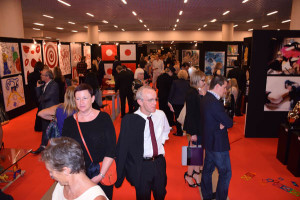Who Attends Exhibitions? What to Expect – Article 8

So you have completed your first exhibition but you are still wondering, who is actually invited and who attends exhibitions. There is a very easy way to figure this out.
The general consensus is that, in a three day show, different types of visitors will pass by your booth. The first day is the VIP or black tie event. This should be a mixture of collectors, buyers, and peers. They look but wait to come back to purchase on the last day. Many times galleries not in the exhibition that are looking for artist to represent will stop by on the first and second day. Collectors do not wear signs. They will not overdress to draw attention to themselves.
Smile, expect great things. Expect that the most fabulous people are going to fall in love with your work and vie to represent you. It can and does happen. So talk to everyone and find out what brings them to the exhibition on this beautiful day. Learn the word for hello in whatever the dominant language is in the country that you are currently in, ”Bonjour”, “Buenos Dias”, etc.
Usually, promoters will advertise a number of patrons, i.e. 50,000 people will attend. At the event is the time to do your homework. Ask your visitors why they are attending. Ideally, you should be able to identify percentages of artists shopping for next year’s booths, students, collectors, galleries, and everyday buyers. It will change each day of the exhibition/show ultimately ending with the last day when the bulk of the sales take place.
Walk around the exhibition. You can wear your name tag or not when you do this. Your tag will identify you to people because the tags are usually printed different depending on your category. Visit the galleries; watch who sells and who does not. Look for the famous red dot. You will see a small inconspicuous round red dot on the tag of art that is sold. Sometimes, you will read contrary results to that which you actually experience while you are there so, do the research yourself. By the last day, you will know these answers as people do talk. Ask questions. There may be the perfect gallery that wants to represent you just around the corner. I was introduced to an excellent gallery by another artist’s representative. Yes I did say representative. Sometimes, solo artists will bring representation to do the selling for them. I have had the pleasure to witness this practice first hand and watched their good results.
If you are paying a fee for a space with no percentage then your sales should at least cover your expenses. Things to look for are the people visiting you and taking a lot of pictures? Are they students? Are they mostly artists looking for space next year? Keep a note book and mark it with observations. Also have a guest book for people to sign in. You will need to make notes. I use a coding system like a star or symbol to put next to the name to remind me to get back in touch. Figure out the percentage of potential buyers or people that can benefit you and your career. This is the way to make educated decisions on the proper use of your funds. Above all, no matter what you discover during your exhibition, make the best out of what cards you are dealt. Make applesauce out of apples and absolutely beyond a shadow of a doubt know that at least one great thing comes out of each and every experience. So look for the great things and they will definitely happen to you.
You goal should be to reach a place in your career where industry leaders believe in your work and will represent you for a percentage of sales and not just look at you, the artist, as just a purchaser of wall space. Be realistic, if you are a professional, being an “artist” is your business and therefore, treat it as such. There are always fees in every business. You just need to be informed so that you spend your hard earned dollars wisely.
